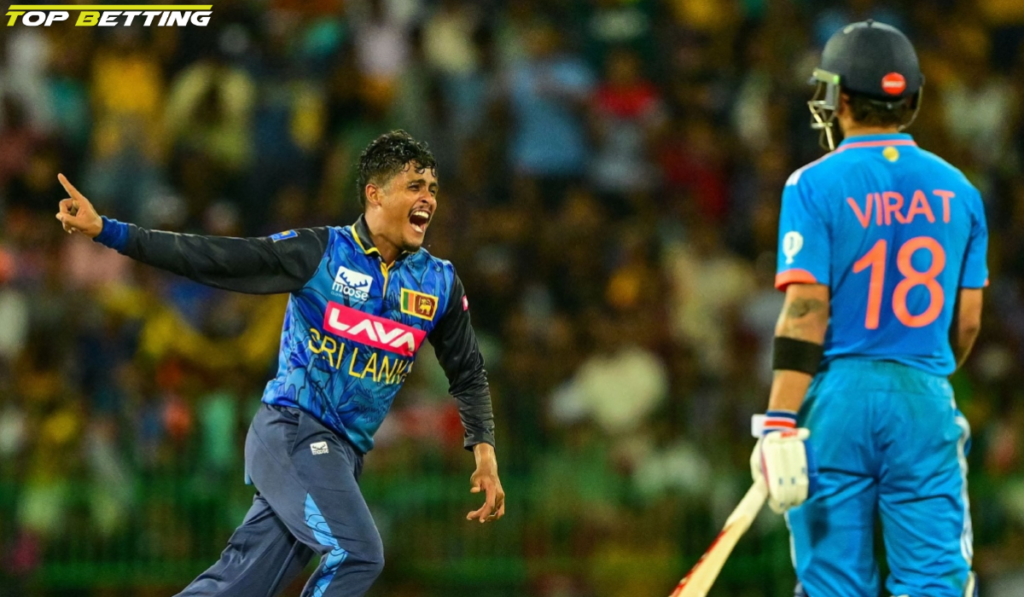

Spinners Jeffrey Vandersay and Charith Asalanka Lead Sri Lanka to Victory as India’s Middle-Order Implodes Again
For the second time in succession, India’s middle-order faltered against spin, resulting in a 32-run defeat against Sri Lanka in the second ODI at the R Premadasa Stadium in Colombo. The Indian batsmen’s inability to handle spin was starkly evident as Jeffrey Vandersay and Charith Asalanka shared nine wickets between them. This match, much like the previous one, highlighted significant concerns for India, particularly in handling spin, which they will need to address swiftly.
A Déjà Vu Collapse
India’s chase of a target of 241 seemed promising initially, courtesy of another strong opening stand. Rohit Sharma continued his fine form, scoring a brisk 64 off 44 balls in a partnership of 97 runs. However, this promising start was undone as India’s middle-order crumbled in a manner eerily similar to their collapse in the previous game. Vandersay’s spell of 6/33 and Asalanka’s contributions were crucial in defending a sub-240 score against India for the first time since 2008.
The Perils of Premadasa Pitch
The Premadasa pitch has historically been challenging for India, particularly against spin. All four instances of India losing the most wickets to spin in an ODI have occurred at this venue. Despite this, Rohit Sharma managed to play with confidence, his half-century being a highlight. But his dismissal, caught superbly by Pathum Nissanka running from backward point, signaled the beginning of India’s troubles.
Middle-Order Woes
Shubman Gill, who showed more resilience compared to his previous outing, managed 35 runs off 44 balls. However, his dismissal was the precursor to India’s middle-order collapse. Kamindu Mendis’s acrobatic catch at slip to dismiss Gill was followed by Vandersay trapping Shivam Dube leg-before with a well-pitched leg-break, which Dube didn’t even bother to review.
Virat Kohli, one of India’s most dependable batsmen, fell victim to another leg-break that sneaked past his inside edge, striking his leg. Shreyas Iyer, too, was deceived in a similar fashion, pressing forward but leaving a gap between bat and pad. Perhaps the most baffling dismissal was that of KL Rahul, who was bowled for a duck while attempting an expansive cut, only to edge the ball onto his stumps.
Sharma’s Reflections
Rohit Sharma, in his post-match address, expressed his disappointment. “When you lose a game, everything hurts. It’s not just about those 10 overs. You have to play consistent cricket, and we failed to do that today. Little disappointed but these things happen. You have got to adapt to what’s in front of you,” said Sharma, emphasizing the need for adaptability and consistency.
Glimmer of Hope
Despite the flurry of wickets, India still had a chance with Axar Patel and Washington Sundar putting together a 38-run partnership for the seventh wicket. Patel’s aggressive approach provided a brief glimmer of hope. In Asalanka’s first over, Patel showcased his intent by hitting a six over extra-cover, followed by a four through square-leg and another through short fine-leg, garnering 14 runs from the over. However, once Patel and Sundar were dismissed in quick succession, India’s hopes dwindled.
Sri Lanka’s Late-Order Resilience
Sri Lanka’s innings, too, had moments of fragility, but they managed to post a competitive total thanks to crucial contributions from their lower order. Kamindu Mendis and Dunith Wellalage’s 72-run stand was instrumental in lifting Sri Lanka from a precarious 136/6. Washington Sundar, Kuldeep Yadav, and Axar Patel kept pegging back Sri Lanka with regular wickets, but the late-order resistance allowed Sri Lanka to post a par total.
Moving Forward
For Sri Lanka, this victory is a significant morale booster, breaking a depressing run in white-ball cricket. The team will look to build on this performance, with Vandersay and Asalanka’s performances highlighting their potential. The tied first match and this victory mean Sri Lanka cannot lose this three-match ODI series, which is a positive outcome for them.
For India, the series has exposed vulnerabilities, particularly in their middle-order’s ability to handle spin. The team management will need to address these issues urgently, perhaps re-evaluating their approach and strategies against spin-heavy attacks. The importance of adaptability and strategic batting cannot be overstated, especially in subcontinental conditions.
Conclusion
The second ODI between India and Sri Lanka was a tale of familiar woes for the Indian team, with their middle-order’s susceptibility to spin being brutally exposed once again. Sri Lanka’s victory, on the other hand, marks a potential turning point for the team, providing a much-needed boost in confidence. As the series progresses, both teams will look to learn from this match, with India focusing on strengthening their middle-order and Sri Lanka aiming to maintain their momentum. The reflections and strategies derived from this game will undoubtedly shape the performances of both teams in the final match of the series and beyond.











